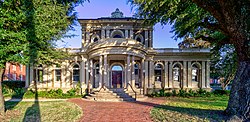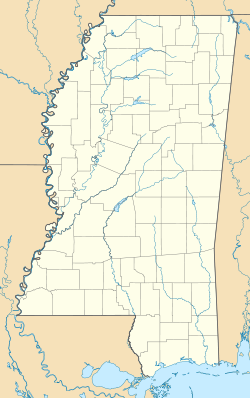
Yazoo County is a county located in the U.S. state of Mississippi. As of the 2020 census, the population was 26,743. The county seat is Yazoo City. It is named for the Yazoo River, which forms its western border. Its name is said to come from a Choctaw language word meaning "River of Death".

The Delta Blues Museum in Clarksdale, Mississippi, United States, is a museum dedicated to collecting, preserving, and providing public access to and awareness of the musical genre known as the blues. Along with holdings of significant blues-related memorabilia, the museum also exhibits and collects art portraying the blues tradition, including works by sculptor Floyd Shaman and photographer Birney Imes.
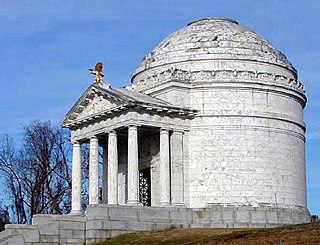
Vicksburg National Military Park preserves the site of the American Civil War Battle of Vicksburg, waged from March 29 to July 4, 1863. The park, located in Vicksburg, Mississippi, flanking the Mississippi River, also commemorates the greater Vicksburg Campaign which led up to the battle. Reconstructed forts and trenches evoke memories of the 47-day siege that ended in the surrender of the city. Victory here and at Port Hudson, farther south in Louisiana, gave the Union control of the Mississippi River.
Glenwood Cemetery may refer to: (sorted by state, then city/town)

Greenwood station is an Amtrak intercity train station in Greenwood, Mississippi, United States. It is a stop on Amtrak's City of New Orleans line. The red brick depot was built around 1917 by the Yazoo and Mississippi Valley Railroad, a subsidiary of the Illinois Central Railroad. It is located in Greenwood's Railroad Historic District, added to the National Register of Historic Places in 1985.

Baton Rouge station is a historic train station located at 100 South River Road in downtown Baton Rouge, Louisiana. It was built for the Yazoo and Mississippi Valley Railroad which got absorbed by the Illinois Central Railroad. The station was a stop on the Y&MV main line between Memphis, Tennessee and New Orleans, Louisiana. The building now houses the Louisiana Art and Science Museum.

The Holly Bluff site, sometimes known as the Lake George Site, and locally as "The Mound Place," is an archaeological site that is a type site for the Lake George phase of the prehistoric Plaquemine culture period of the area. The site is on the southern margin of the Mississippian cultural advance down the Mississippi River and on the northern edge of that of the Cole's Creek and Plaquemine cultures of the South." The site was first excavated by Clarence Bloomfield Moore in 1908 and tested by Philip Phillips, Paul Gebhard and Nick Zeigler in 1949.

The Winterville site is a major archaeological site in unincorporated Washington County, Mississippi, north of Greenville and along the river. It consists of major earthwork monuments, including more than twelve large platform mounds and cleared and filled plazas. It is the type site for the Winterville Phase of the Lower Yazoo Basin region of the Plaquemine Mississippian culture. Protected as a state park, it has been designated as a National Historic Landmark.
The Aden site is an archaeological site that is the type site for the Aden phase of Lower Yazoo Basin Coles Creek culture chronology. It corresponds to Middle Coles Creek, chronologically between the Bayland phase and Kings Crossing phase.
A Mississippi Landmark is a building officially nominated by the Mississippi Department of Archives and History and approved by each county's chancery clerk. The Mississippi Landmark designation is the highest form of recognition bestowed on properties by the state of Mississippi, and designated properties are protected from changes that may alter the property's historic character. Currently there are 890 designated landmarks in the state. Mississippi Landmarks are spread out between eighty-one of Mississippi's eighty-two counties; only Issaquena County has no such landmarks.
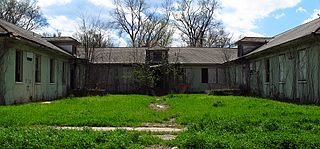
The Afro-American Sons and Daughters Hospital, in Yazoo City, Mississippi, also known as the Afro-American Hospital, was built in 1928. It was listed on the National Register of Historic Places in 2006.

This is a list of the National Register of Historic Places listings in Yazoo County, Mississippi.

Ruleville Depot is a historic railroad depot on the east side of railroad tracks at the junction of East Floyce Street and North Front Street in Ruleville, Mississippi. It was constructed in 1930 by the Yazoo and Mississippi Valley Railroad following its purchase by the Illinois Central Railroad. Railway service to Ruleville began in 1897, when the Yazoo Delta Railroad built a line to the city; the original 1897 depot was replaced in 1913 after a tornado hit it, and the 1913 building was in turn replaced by the 1930 building. The station received both passenger and freight service, with two passenger trains and multiple freight trains serving the station each day. Passenger service to the station ended in the 1950s, and the station closed entirely in 1978. It is currently owned by the Ruleville Chamber of Commerce.

The Augustus J. Oakes House is a historic residence in Yazoo City, Mississippi. Augustus J. Oakes was the founder of the private Oakes Academy school for African Americans in 1884. He was married to Emma Johnson Oakes and is buried in Yazoo City's Glenwood Cemetery. The house was added to the National Register of Historic Places on April 8, 1993. It is located at 308 Monroe Street.
Foote is an unincorporated community in Washington County, Mississippi, United States. Variant names include Colmere and Dudley.
The Carson Mounds, also known as the Carson Site and Carson-Montgomery- is a large Mississippian culture archaeological site located near Clarksdale in Coahoma County, Mississippi, United States, in the Yazoo Basin. Only a few large earthen mounds are still present at Carson to this day. Archaeologists have suggested that Carson is one of the more important archaeological sites in the state of Mississippi.

The Mosely-Woods House is a historic house located near Yazoo City, Mississippi. The house is notable for its Greek Revival architecture and its significance as one of the earliest African-American-owned residences in the area, continuously owned by the same family since 1880.
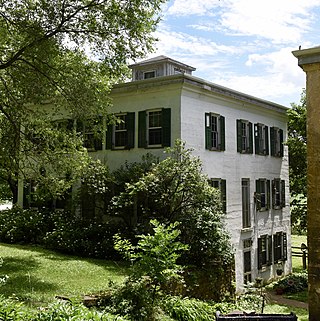
Paradise Farm are historic agricultural and domestic buildings located west of Bellevue, Iowa, United States. Massachusetts native Elbridge Gerry Potter settled near Big Mill Creek in 1842 from Illinois. He arrived here with 500 head of cattle, 40 teams of mules, and money. In addition to this farm he operated a flour mill and sawmill in Bellevue, and established steamboat lines on the Mississippi River at Bellevue, on the Yazoo River in Louisiana and the Red River in Texas.
Fort Pemberton is a historic artillery battery located at Leflore County, Greenwood, Mississippi. It was built in early 1863 during the Vicksburg Campaign of American Civil War. The fort was located on the route of the Yazoo Pass, near the confluence of the Tallahatchie and Yalobusha Rivers. Fort Pemberton was listed on the National Register of Historic Places on June 19, 1973.
